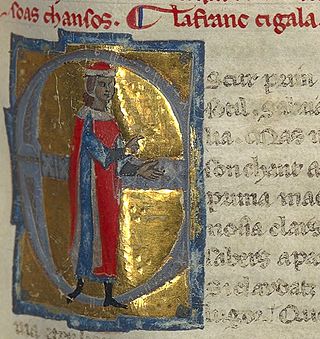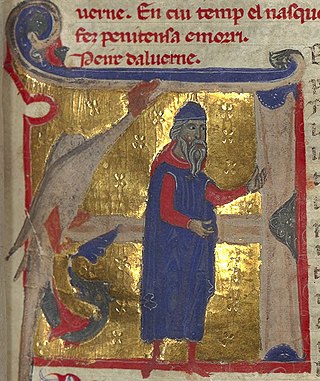Boniface I, usually known as Boniface of Montferrat, was the ninth Marquis of Montferrat, a leader of the Fourth Crusade (1201–04) and the king of Thessalonica.

Peire Cardenal was a troubadour known for his satirical sirventes and his dislike of the clergy. Ninety-six pieces of his remain, a number rarely matched by other poets of the age.

Marcabru is one of the earliest troubadours whose poems are known. There is no certain information about him; the two vidas attached to his poems tell different stories, and both are evidently built on hints in the poems; not on independent information.

Lanfranc Cigala was a Genoese nobleman, knight, judge, and man of letters of the mid thirteenth century. He remains one of the most famous Occitan troubadours of Lombardy. Thirty-two of his poems survive, dealing with Crusading, heresy, papal power, peace in Christendom, and loyalty in love. Lanfranc represented a tradition of Italian, Occitan-language trovatori who berated the Papacy for its handling of the Crusades.

Peirol or Peiròl was an Auvergnat troubadour who wrote mostly cansos of courtly love in the late twelfth and early thirteenth centuries. Thirty-four surviving poems written in Occitan have been attributed to him; of these, seventeen have surviving melodies. He is sometimes called Peirol d'Auvergne or Peiròl d'Auvèrnha, and erroneously Pierol.

Peire d'Alvernhe or d'Alvernha was an Auvergnat troubadour with twenty-one or twenty-four surviving works. He composed in an "esoteric" and "formally complex" style known as the trobar clus. He stands out as the earliest troubadour mentioned by name in Dante's Divine Comedy.
Olivier lo Templier was a Knight Templar and troubadour probably from Catalonia. He appears as lo templier En'Olivier in one chansonnier, in which is preserved his only known work, Estat aurai lonc temps en pessamen. He may be identical with Ramon Oliver who appears as commander of the Templar house of Gardeny near Lleida in 1295. He should not be confused with another troubadour Templar, Ricaut Bonomel, whose style was very different and who wrote from the Holy Land.

Uc, Uco, or Ugo de Pena or Penna was a troubadour of the late 12th and early 13th centuries. He left behind three cansos and no music.
UcCatola was a knight and early troubadour, possibly a participant in the Second Crusade and perhaps later a monk.
Gavaudan was a troubadour and hired soldier at the courts of both Raymond V and Raymond VI of Toulouse and later on in Castile. He was from Gévaudan, as his name implies. He wrote moralising lyrics, either religious or political, and ten of his works survive, including five sirventes, two pastorelas, one canso, one planh for an anonymous domna (lady), and one Crusade song. He is sometimes clumped in a primitive Marcabrunian "school" of poetry alongside Bernart Marti, Bernart de Venzac, and Peire d'Alvernhe. He developed a hermetic style, combining elements of the trobar ric and trobar clus.
Austorc de Segret or Austau de Segret was an Auvergnat troubadour with only one surviving sirventes, "No sai quim so, tan sui desconoissens".
Peire Lunel de Montech, also known as Cavalier Lunel or Peire de Lunel, was a lawyer, politician and author of Toulouse. His name indicates he was a knight from Montech.

Raimon de Cornet was a fourteenth-century Toulousain priest, friar, grammarian, poet, and troubadour. He was a prolific author of verse; more than forty of his poems survive, most in Occitan but two in Latin. He also wrote letters, a didactic poem, a grammar, and some treatises on computation. He was the "last of the troubadours" and represented l'esprit le plus brillant of the "Toulousain School". He appears in contemporary documents with the titles En and Frare.
Bertran Folcon d'Avignon or Bertran Folco d'Avinhon was a Provençal nobleman and troubadour from Avignon. He was a faithful partisan of Raymond VI and Raymond VII of Toulouse in Provence, and participated in the wars against the Albigensian Crusade. He was inside the city during the siege of Beaucaire in 1216. In 1226 Raymond VII appointed him bailiff of Avignon.
A Crusade song is any vernacular lyric poem about the Crusades. Crusade songs were popular in the High Middle Ages: 106 survive in Occitan, forty in Old French, thirty in Middle High German, two in Italian, and one in Old Castilian. The study of the Crusade song, which may be considered a genre of its own, was pioneered by Kurt Lewent. He provided a classification of Crusade songs and distinguished between songs which merely mentioned, in some form, a Crusade from songs which were "Crusade songs". Since Lewent, scholars have added several classifications and definitions of Crusade songs. Scholars have argued for three different classifications of Crusade songs which include songs of exhortation, love songs, and songs which criticize the Crusading movement.
Guilhem or Guillem Fabre was a troubadour and burgher from Narbonne. He may be the same person as the dedicatee of En Guillems Fabres, sap fargar, a eulogistic poem by Bernart d'Auriac. He was one of several mid- to late-thirteenth-century troubadours from Narbonne, with Bernart Alanhan and Miquel de Castillon.
Murgleys, or Murgleis is the sword of Ganelon, a traitorous French (Frankish) count and nemesis to the titular hero of the epic La chanson de Roland.
Gouffier of Lastours was a knight from Lastours in the Limousin in France, who participated in the First Crusade. He was lord of the Château de Lastours, near Nexon, Haute-Vienne.
Baldwin of Marash was a Crusader baron in northern Syria, the lord of Marash from at least 1136.
In the Middle Ages, criticism of crusading was a minority opinion in western Europe. By contrast, the crusades in general were roundly criticized in the Byzantine Empire and unanimously condemned in the Islamic world.







